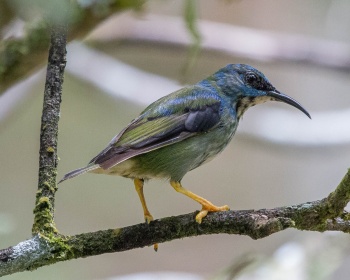- Cyanerpes lucidus
Identification
10 cm
Male
- Purple plumage
- Black wings, tail and throat
- Long black decurved bill
- Bright yellow legs
Female
- Green upperparts
- Greenish-blue head
- Buff throat
- Buff-streaked bluish underparts
Immature: similar to the female, but has a greener head and breast.
Distribution
Central and South America:
Central America: Mexico, Guatemala, Belize, El Salvador, Honduras, Nicaragua, Costa Rica and Panama
South America: found only in Colombia.
Taxonomy
Subspecies
There are 2 subspecies[1]:
- C. l. lucidus:
- C. l. isthmicus:
- Costa Rica to Panama and extreme north-western Colombia
Habitat
Forest canopy and forest edges.
Behaviour
Diet
The diet includes nectar, berries and insects.
Breeding
The female builds a cup-shaped nest which is placed in a tree - she also incubates the two eggs.
References
- Clements, J. F., T. S. Schulenberg, M. J. Iliff, D. Roberson, T. A. Fredericks, B. L. Sullivan, and C. L. Wood. 2015. The eBird/Clements checklist of birds of the world: v2015, with updates to August 2015. Downloaded from http://www.birds.cornell.edu/clementschecklist/download/
- Avibase
- Wikipedia
Recommended Citation
- BirdForum Opus contributors. (2025) Shining Honeycreeper. In: BirdForum, the forum for wild birds and birding. Retrieved 18 May 2025 from https://www.birdforum.net/opus/Shining_Honeycreeper
External Links
GSearch checked for 2020 platform.1






